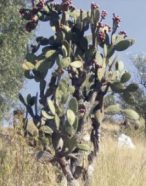Cactus goo for clean water
A cactus commonly found in Mexico can help clean up dirty water.
By Emily Sohn
People need water to survive, and the water has to be clean—or they get very sick. Clean water, however, can be hard to come by.
Now, scientists are exploring a clever way to make dirty water clean for small communities in Mexico. The secret is the goo from an edible cactus found all over that country.
 |
|
The nopal cactus, or prickly pear, could help Mexican communities purify drinking water.
|
| Norma Alcantar |
Long ago, people in Latin America used prickly pear cactuses to filter their water, says Norma Alcantar. She’s a chemical engineer at the University of South Florida in Tampa.
First, they would boil the plant, which they could eat. They then dumped the boiled water into their drinking water. Gritty particles settled to the bottom, and the water on top was good to drink.
To see if they could revive this practice, Alcantar and her coworkers studied a material called mucilage, which they extracted from cactus plants. Mucilage is a thick, gooey substance that allows the plant to store water.
The researchers already knew that adding mucilage to contaminated water causes floating particles to sink to the bottom. They wanted to know how it works.
To figure out what cactus mucilage does, the scientists separated it into two parts—a liquid and a gel. Tests on the gel portion showed that this goo alone could filter water. Even better, the process took just 5 minutes. Aluminum sulfate, a chemical commonly used in water-treatment plants, takes three times as long.
In other tests, cactus goo cleared water of half of its arsenic, a toxic chemical, after 36 hours.
Next, the researchers plan to test the liquid portion of the cactus mucilage. They also want to figure out which molecules in the goo are doing the job. One goal is to find out how much goo is needed to clean a Mexican village’s water supply.
By next summer, the scientists hope to have a cactus filtering system set up in a Mexican city called Temamatla. The water there is full of grit and arsenic, and there are lots of cactuses around. It’s the perfect place to find out whether these spiny plants can help provide clean, healthy water.—E. Sohn
Going Deeper:
Cunningham, Aimee. 2005. Cactus goo purifies water. Science News 168(Sept. 17):190. Available at http://www.sciencenews.org/articles/20050917/note14.asp .
You can learn more about the nopal, or prickly pear, cactus at www.womenandinfants.com/body.cfm?id=388&chunkiid=21820 (Women and Infants Hospital of Rhode Island) and en.wikipedia.org/wiki/Prickly_pear and en.wikipedia.org/wiki/Opuntia_ficus-indica (Wikipedia).







